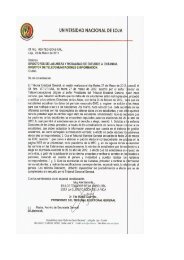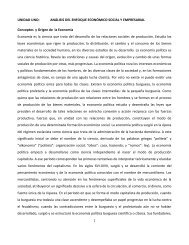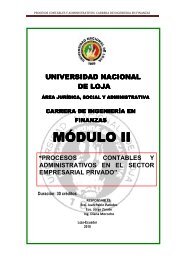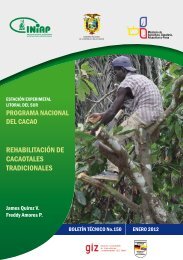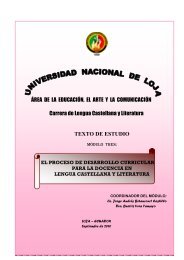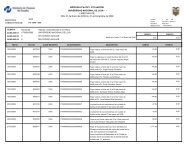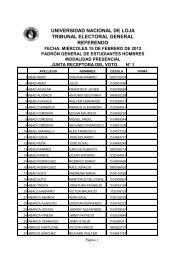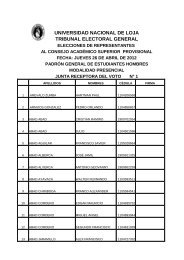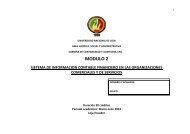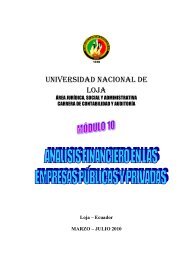module 5 planning of the english language teaching-learning process
module 5 planning of the english language teaching-learning process
module 5 planning of the english language teaching-learning process
Create successful ePaper yourself
Turn your PDF publications into a flip-book with our unique Google optimized e-Paper software.
UNIVERSIDAD NACIONAL DE LOJA<br />
Área de la Educación el Arte y la Comunicación<br />
English Language Career<br />
5. Point out to <strong>the</strong> students that you can<br />
count some nouns but you can’t<br />
count o<strong>the</strong>rs.<br />
These are called countable and un<br />
countable nouns. You use a with<br />
singular countable nouns or plural<br />
countable nouns.<br />
6. Ask <strong>the</strong> students some concept<br />
questions, e.g. ‘Which <strong>of</strong> <strong>the</strong> food<br />
items on <strong>the</strong> board are countable/un<br />
countable/singular/plural?’<br />
7. Students do a written gap-fill<br />
exercise, filling <strong>the</strong> gaps with a or<br />
some.<br />
8. Students work in pairs with a<br />
worksheet <strong>of</strong> pictures <strong>of</strong> food and<br />
drink like for <strong>the</strong>ir party, e.g. ‘I’d like<br />
some/a……’, while <strong>the</strong> o<strong>the</strong>r student<br />
takes notes. Then <strong>the</strong>y swap roles.<br />
<strong>the</strong> teacher tells <strong>the</strong> students<br />
about any <strong>language</strong> she noticed<br />
<strong>the</strong>y didn’t know while <strong>the</strong>y were<br />
doing <strong>the</strong> task, e.g. <strong>the</strong><br />
pronunciation <strong>of</strong> some food<br />
words, <strong>the</strong> grammar <strong>of</strong><br />
uncountable and countable<br />
nouns.<br />
7. Students do a written exercise<br />
on <strong>the</strong> new <strong>language</strong>.<br />
The introductory stage <strong>of</strong> a lesson helps students to settle into <strong>the</strong> lesson and<br />
focus on its content. There are two kinds <strong>of</strong> introductory activities: warmers<br />
and lead-ins. Warmers <strong>of</strong>ten used to raise students' energy levels or to make<br />
<strong>the</strong>m feel comfortable. They are not always connected to <strong>the</strong> topic <strong>of</strong> <strong>the</strong> lesson,<br />
for example, <strong>the</strong>y could be a quiz, game or pairwork activity. Lead-ins focus<br />
on <strong>the</strong> topic or new <strong>language</strong> <strong>of</strong> tire lesson. They can also focus motivate<br />
students and make a link between <strong>the</strong> topic <strong>of</strong> <strong>the</strong> lesson and <strong>the</strong> students'<br />
own I (personalization). For example, if in one lesson students are going to<br />
read a text about Internet, ra<strong>the</strong>r than giving <strong>the</strong>m <strong>the</strong> text immediately, we<br />
could do one or more lead-in activities such as discussing with students how<br />
<strong>of</strong>ten <strong>the</strong>y use <strong>the</strong> Internet what <strong>the</strong>y use it what <strong>the</strong>ir favorite websites are,<br />
etc. Or if in ano<strong>the</strong>r lesson <strong>the</strong>y are going to listen conversation about favorite<br />
television programmes, <strong>the</strong> lead-in activities might be making a list <strong>of</strong> <strong>the</strong>ir favorite<br />
television programmes and discussing <strong>the</strong>m with a partner. These activities;<br />
probably lead on to <strong>teaching</strong> relevant vocabulary for <strong>the</strong> texts and<br />
comprehension task follow.<br />
If you look back at <strong>the</strong> PPP and TBL lessons on page 61 you will see that <strong>the</strong>y<br />
too include introductory activities. Step 1 in <strong>the</strong> PPP lesson provides a lead-in to<br />
<strong>the</strong> topic, and steps 2 and 3 a lead-in for <strong>language</strong> needed for <strong>the</strong> lesson's main<br />
aim. In <strong>the</strong> TBL lesson, steps 1 and 2 are lead-ins.<br />
Key concepts and <strong>the</strong> <strong>language</strong> <strong>teaching</strong> classroom<br />
The two lessons on pages 61-2 show two common and different approaches to<br />
presenting <strong>language</strong> items. The lesson on <strong>the</strong> left is an example <strong>of</strong> a PPP<br />
lesson, <strong>the</strong> lesson on <strong>the</strong> right a example <strong>of</strong> a TBL lesson. There are many<br />
differences between <strong>the</strong>m.<br />
[Escribir texto] Página 61



